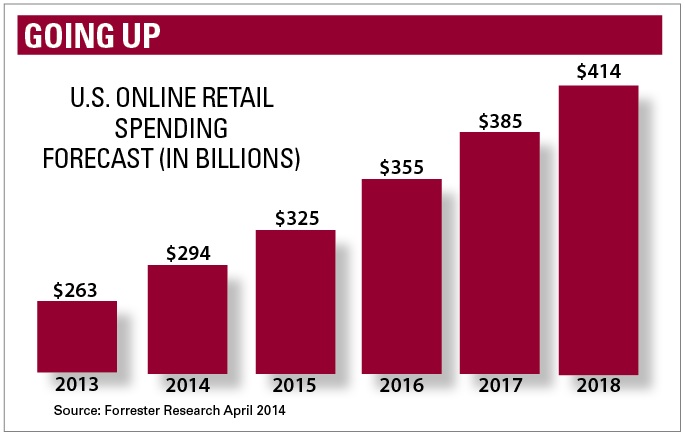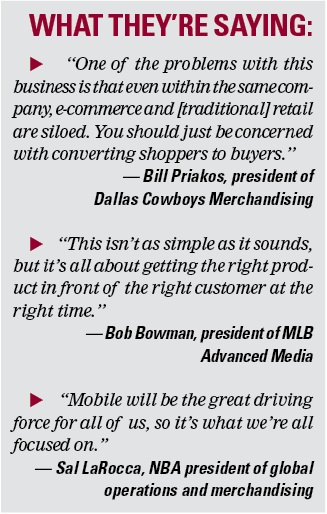It’s February 2024 at Aflac Field in Atlanta, where fans have just watched the Cleveland Browns win their first Super Bowl. A championship T-shirt or cap is a must for victory-starved Clevelanders, who haven’t witnessed a pro sports championship for 60 years.
No merchandise is in sight, however. Instead, every interested fan uses his mobile device to swipe a bar code on his ticket and the requisite items are either available at distribution centers the size of drive-up banks on his way home or delivered to home the next morning — by drones.
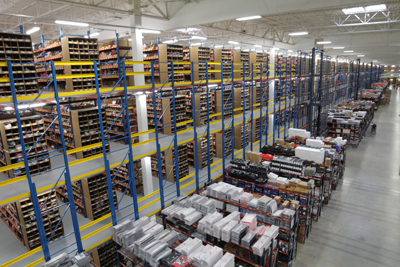 |
Inside Fanatics’ giant distribution center in Ohio, one of four such facilities the company has in the U.S.
Photo by: Fanatics |
A fanciful forecast? Perhaps. Still, the exploding importance and potency of mobile commerce, social media and big data are combining to change the face of retail dramatically.
Currently, online retail of licensed sports products domestically ranges from 7 percent to 10 percent for most large sports properties and brick-and-mortar sports specialty retailers. Projections of how much licensed sports business will shift from traditional retail to online commerce range from 20 percent to as high as 50 percent.
That most optimistic forecast comes from industry behemoth Fanatics, which services every big stick-and-ball league’s e-commerce needs, NASCAR, and more than 150 collegiate and professional teams, along with its own omnibus Fanatics.com site.
“There will always be a big business at venues and in on-campus bookstores,” said Doug Mack, a 17-year e-commerce veteran, who recently joined Fanatics as CEO. “We see the share from places like malls and stand-alone stores shifting aggressively online. You look at someone like Williams-Sonoma in home furnishings, which is a hybrid of online, catalog and brick-and-mortar retail, and half of their business is online already. So I’m actually thinking 50 percent is a bare minimum for a long-term goal.”
Mobile marketing
The advent of mobile commerce has given consumers unprecedented access to information about price and product. With sports, there are already impressive traffic numbers.
Half of all traffic to Fanatics.com and all the league and team sites it administers is mobile generated. After the
Seattle Seahawks won the Super Bowl in February, around 65 percent of consumers seeking Seahawks merchandise on Fanatics’ sites did so via mobile devices.
The prospect of whatever we will be calling “phones” in five or 10 years replacing payment cards and cash as the payment system of choice means a shift of billions of dollars.
“Mobile will be the great driving force for all of us, so it’s what we’re all focused on,’’ said Sal LaRocca, the NBA’s president of global operations and merchandising. “Mobile’s just a big way of how people are living their lives … it’s an anytime convenience. Fans want that kind of instant gratification.”
Catherine Gammon, senior vice president of brand development at Collegiate Licensing Co., cited projections that by 2017, a quarter of all online purchases will be transacted from a mobile device.
“Looking at that, I don’t see why online licensed sales shouldn’t move to 30 or 40 percent in the next five to eight years,” she said. “It’s just an easier way of capturing consumers in the moment and capitalizing on that impulse purchase.”
Customer experience are the buzzwords often heard when you ask what matters most to online shoppers.
“Everything’s one channel now, so we took over our e-commerce for consistency across the brand,” said Mitchell Modell, who heads the 155-store Modell’s sporting goods chain. “To me, it’s about selection and getting customers in and out quickly, but I would say that’s still a work in progress.”
Modell’s ships e-commerce purchases out of its warehouse distribution center and 40 of its retail locations, presaging tomorrow’s hybrid online/offline hybrid retailer.
Other big sports retailers have taken their e-commerce in-house, especially interesting since that was the business that built Fanatics’ predecessor, GSI Commerce.
“Just a few years ago, nearly every big retailer was going third-party. Now many of the bigger ones are taking it in house, because they see what’s at stake and want to control their own destiny,” said Gary Dubiel, vice president of retail development at Collegiate Licensing Co.
Dubiel cites the 306-store Belk department store chain as a paradigm of the forthcoming hybrid retailer, noting that in Belk stores, there are perhaps 50 different licensed product SKUs, while online there are close to 1,500.
Within the licensed sports industry, one of the most intriguing hybrid models is offered by Dallas Cowboys Merchandising, which runs the team’s e-commerce, shipping out of a 400,000-square-foot warehouse in Dallas.
Cowboys Merchandising also operates 33 brick-and-mortar stores, within which customers are encouraged to order online. Those who do so are offered free shipping. No accident then, that e-commerce already accounts for 17 percent of the Cowboys’ merchandise sales.
“One of the problems with this business is that even within the same company, e-commerce and [traditional] retail are siloed,” said Cowboys Merchandising President Bill Priakos. “You should just be concerned with converting shoppers to buyers.”
A new format Cowboys store, being tested later this year in San Antonio, will push that hybrid model further.
Within that store at the Rivercenter Mall, cash registers will be replaced by “walk around” sales associates with tablets, who will sell items from store shelves or the Cowboys’ website, where the selection is at least five times greater.
Data driven
Like their catalog antecedents, e-commerce retailers can get obsessive about logistics. Issues like whether warehouse shelves should move to the picker or vice-versa can become contentious. Increasingly, however, it’s the influence of big data that is becoming paramount.
As predictive shopping models, of the type pioneered by Amazon, and personalized shopping experiences come to the forefront, collecting and mining customer data will become as important as picking, packing and shipping.
“The No. 1 priority for everyone is database marketing and building a good database to serve that,” said Steve
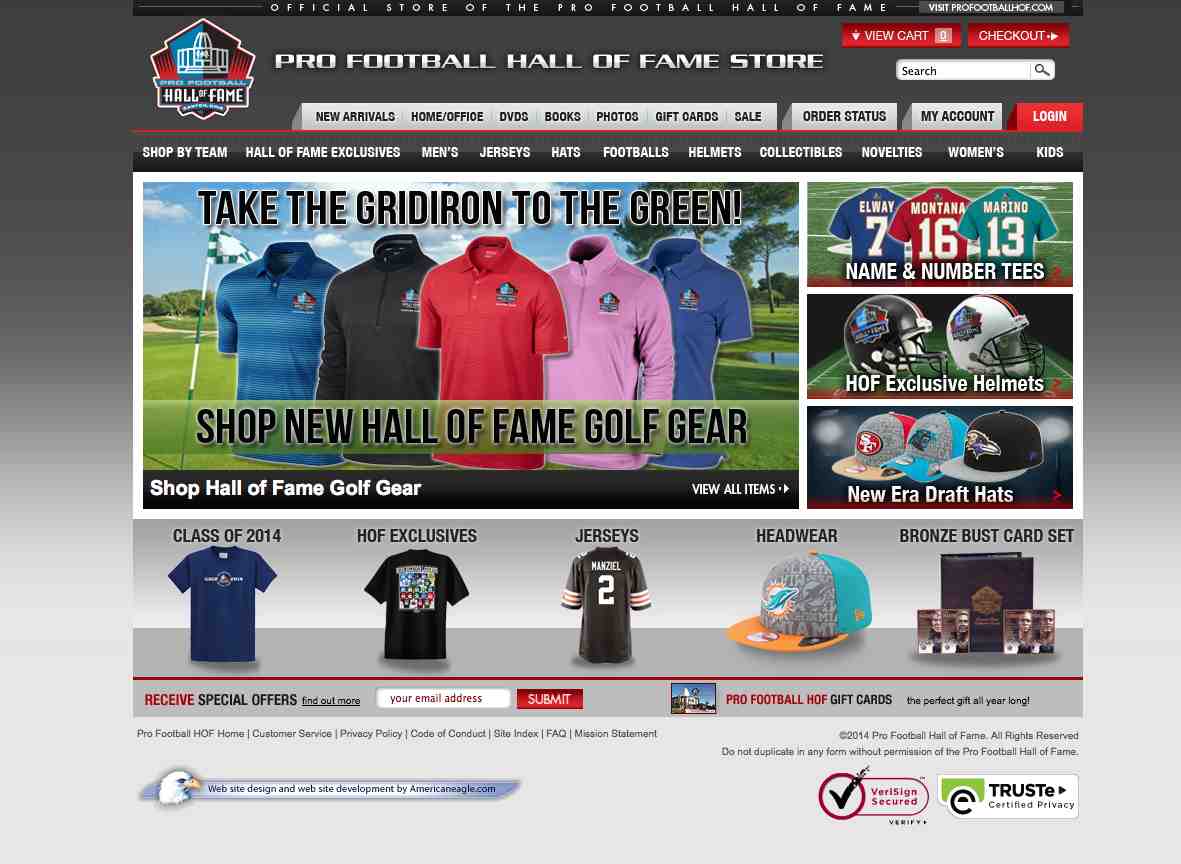 |
| Retail sites are making a push to mine more data from consumers so they can provide more personalized offers and drive sales. |
Strawbridge, vice president of merchandise sales and licensing at the Pro Football Hall of Fame. He said he easily could see the hall’s e-commerce sales increasing from 15 percent to 25 percent of sales within around three years.
“This isn’t as simple as it sounds, but it’s all about getting the right product in front of the right customer at the right time,” said MLB Advanced Media President Bob Bowman. Add the promise of marketing via geo location and it gets more intriguing — online or offline.
“If you’re standing outside a Dick’s store and we can tell you that your favorite jersey is on sale, well, that’s some mobile advertising consumers who have opted in with us will want,” Bowman said. “There’s a new generation of mobile shoppers, so it’s up to us to be more relevant based on who, what, where they are.”
Aside from the advantage of being the largest “pure play” e-commerce retailer of licensed sports products, and the experience and connections Chairman Michael Rubin has after 30 years in sporting goods retail and 15 in e-commerce, Fanatics established itself through paying huge rights fees to the largest sports properties, building Fanatics’ credibility on the back of the NFL and its league brethren.
Now, those are less important. The St. Louis Rams recently switched e-commerce providers to Fanatics after more than five years with competitor MainGate.
“It’s not about huge guarantees anymore,” said Bob Reif, Rams executive vice president and CMO. “It’s really about the data. Now that we have a fully installed CRM, mining data is where the real growth is. The number I keep hearing from Ticketmaster is that a billion people attend U.S. sporting events, but the venues and teams only know around 3 percent of those customers.’’
Brian Killingsworth, the Rams’ vice president of marketing and brand strategy, said: “Assortment and having 1,200 or 1,300 SKUs was important. The CRM aspects were what clinched it, because we need to know as much about our customers as possible.”
The Rams’ product assortment for next season will include items commemorating the 15th anniversary of the team’s “Greatest Show on Turf” championship team.
Social business
Sports generate so much of the conversations in social media that some see the continued growth and influence of social media as an engine that will drive more fans to e-commerce.
“Our social media reach with fans is extraordinary,’’ said LaRocca, citing Dick’s and Finish Line for their use of social media. “So as that increases, we should be able to monetize that within the framework of mobile commerce.”
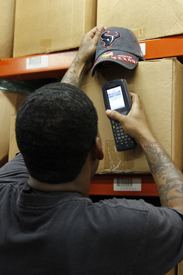 |
A Fanatics worker scans merchandise to fill an order.
Photo by: Fanatics |
While social media certainly attracts the classic “heavy users” that marketers covet, others say translating social media into e-commerce sales has been challenging.
“We’re trying desperately to get Instagram, Twitter and Facebook to produce results and we continue to struggle,” said Strawbridge, estimating that email blasts are 50 times more effective than social media, as far as stimulating e-commerce sales. “We’ve even offered higher discounts on social media, but email is by far the most effective.
They [social media users] just don’t respond to 25 percent off — today only.”
League types are quick to point out that they are not predicting the end of big box sports specialty retailers like Dick’s and The Sports Authority.
“They are important partners for every league,” said MLBAM’s Bowman, “but there are two sides. The No. 1 negative about buying [licensed merchandise] online is that you can’t wear it that day. But the other side is that [brick-and-mortar retail] doesn’t and may never do a good job of servicing the displaced fan.”
As e-commerce matures, some things are changing rapidly; others are enduring.
“Even with all the technology we’re looking at, some things don’t change,” said the Cowboys’ Priakos. “Mondays are still really big for us. People come in to the office bored after the weekend and I guess one of the first things they do is go shopping.”



